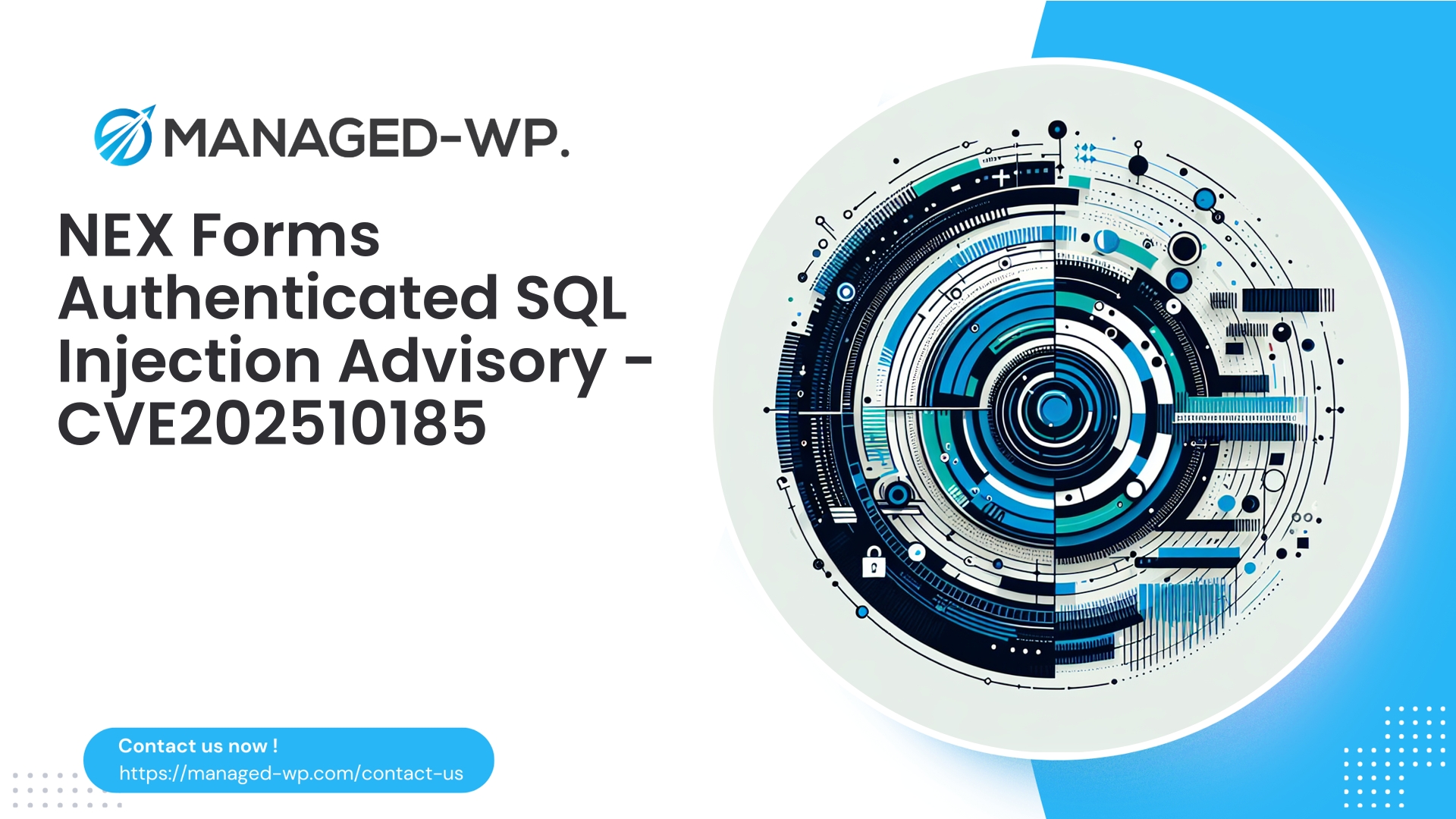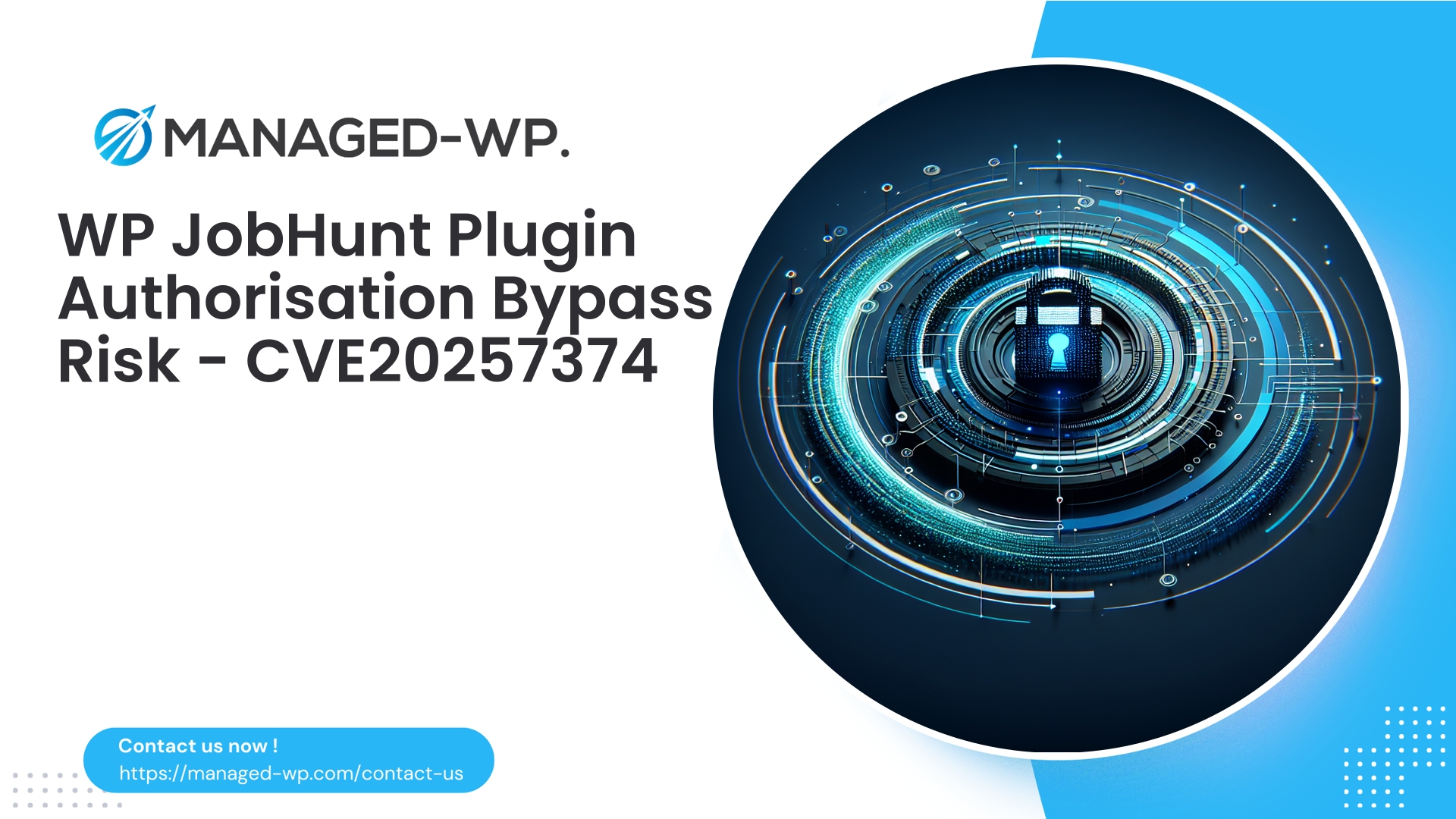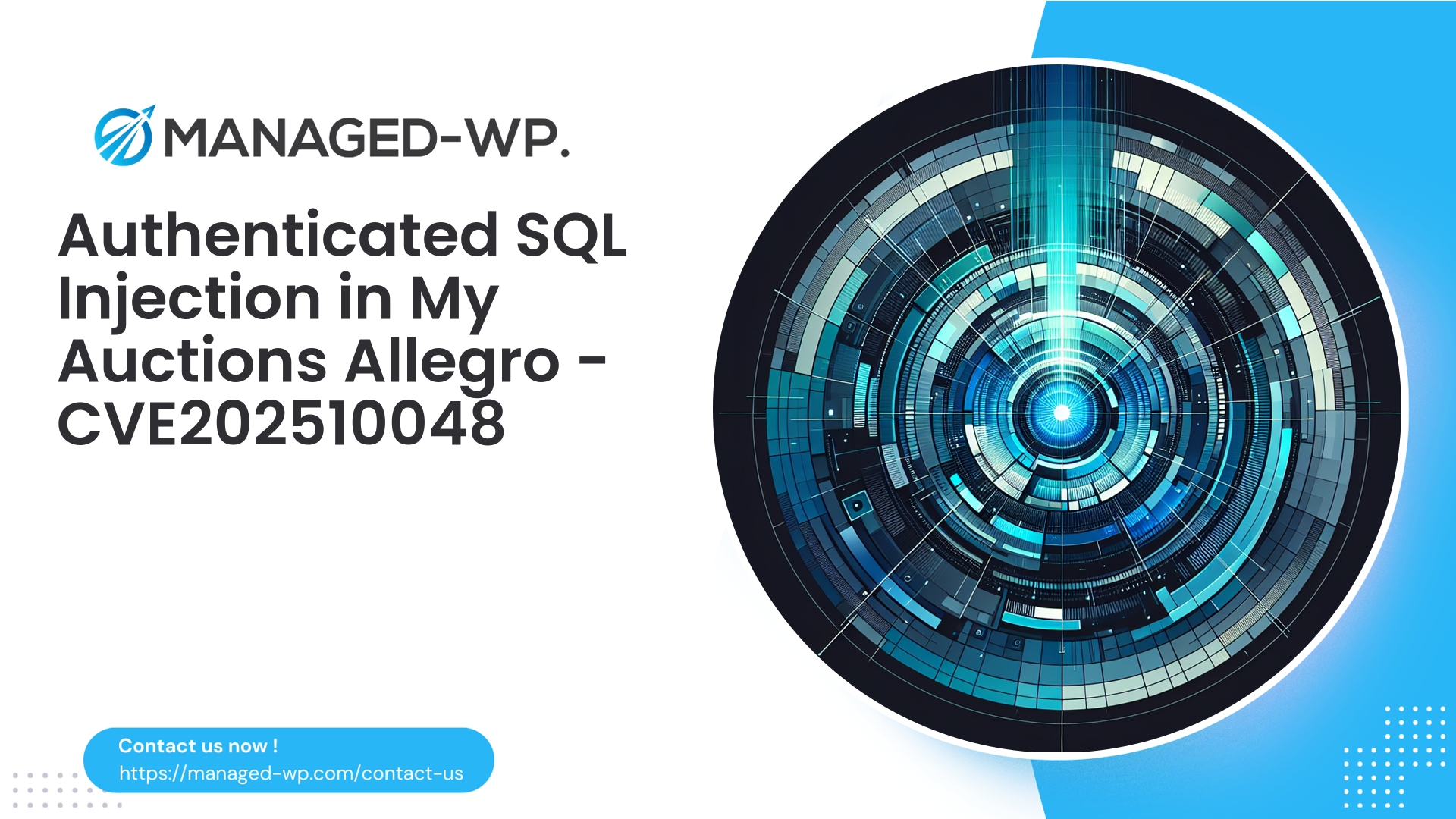| 插件名称 | NEX-Forms |
|---|---|
| 漏洞类型 | 已认证的 SQL 注入 |
| CVE编号 | CVE-2025-10185 |
| 紧急 | 低的 |
| CVE 发布日期 | 2025-10-10 |
| 源网址 | CVE-2025-10185 |
NEX-Forms <= 9.1.6 — 已认证管理员 SQL 注入漏洞 (CVE-2025-10185):美国安全专家为 WordPress 网站所有者提供的关键见解
发布日期: 2025年10月10日
作者: 托管 WordPress 安全团队
执行摘要
- 漏洞: NEX-Forms WordPress 插件中存在经过身份验证的 SQL 注入漏洞,编号为 CVE-2025-10185。
- 受影响版本: NEX-Forms 版本最高至 9.1.6。
- 修复程序已发布: 9.1.7 版本解决了这个漏洞。
- 需要访问权限: 管理员(已认证用户)权限。
- 风险等级: 虽然紧急程度较低,但由于可能存在攻击链,仍应谨慎对待。
- 建议采取的措施: 立即升级;实施严格的管理员访问策略;部署托管 Web 应用程序防火墙 (WAF) 保护作为临时屏障。
本简报详细阐述了漏洞的技术范围、实际的利用路径、检测策略、快速缓解措施以及安全最佳实践——所有这些都经过了为美国企业和机构服务的 Managed-WP 专家团队的审查。
目录
- 即使病情轻微,也要了解其影响
- 技术解析:身份验证 SQL 注入详解
- 潜在攻击场景及其展开过程
- 立即响应清单:每个网站所有者都应该做什么
- 检测指标:监控日志和活动
- 虚拟补丁和WAF策略实现快速防御
- WordPress 管理员的长期运营安全
- 面向插件开发者的安全编码建议
- Managed-WP 如何防御这种威胁
- 入门指南:Managed-WP 的免费保护计划
- 最后说明和宝贵资源
1)即使严重程度不高,也要了解其影响
尽管 CVE-2025-10185 由于需要经过身份验证的管理员访问权限而被标记为“低”优先级,但美国网络安全专家强调,此类漏洞需要立即关注,因为:
- 管理员帐户代表 WordPress 网站上的最高权限级别,并且经常成为通过网络钓鱼、撞库攻击或会话劫持等手段窃取凭据的目标。
- 成功利用此漏洞可进行 SQL 注入攻击,从而操纵数据库,暴露敏感数据,包括用户电子邮件、密码、API 密钥和关键配置。
- 低优先级漏洞通常是复杂的多步骤攻击链的组成部分,从而加剧了其影响。
- 像 NEX-Forms 这样的表单插件会处理用户提交的数据,这些数据可能包含个人身份信息 (PII),从而增加数据被盗的风险。
从本质上讲,匿名攻击者无法立即利用此漏洞,但一旦管理员凭据泄露或成为攻击目标,就会变得极其危险。
2)技术解析:已认证 SQL 注入详解
SQL注入(SQLi)漏洞是指未经过滤的用户输入直接嵌入到SQL查询中。在这种情况下,该漏洞仅限于已通过身份验证的管理员,这意味着:
- 存在漏洞的接口位于管理面板或管理员专用的 AJAX 端点中。
- 输入验证不当会导致精心构造的 SQL 命令干扰数据库语句,从而造成数据泄露或篡改。
- 拥有管理员凭据的攻击者可以利用此漏洞操纵超出预期范围的数据库。
由于该漏洞需要管理员身份验证,因此修复措施包括修补插件代码(上游版本 9.1.7 已完成)以及加强服务器端防御,例如访问限制和监控。
3)潜在攻击场景及其发展过程
- 管理员凭证泄露: 攻击者利用被盗或薄弱的管理员凭据,可以利用 SQL 注入漏洞提取敏感数据、更改网站内容或建立持久后门。
- 网络钓鱼和会话劫持: 恶意行为者可能会诱骗管理员发送精心构造的请求,尤其是在缺乏适当的 CSRF 保护的环境中。
- 复杂环境下的权限提升: 在多站点或插件较多的 WordPress 设置中,小的泄漏与此漏洞相结合可能会加剧安全漏洞的影响。
- 数据盗窃与持久化: 攻击者可能会注入管理员帐户或导出个人表单数据,包括敏感提交内容。
虽然未经身份验证的直接攻击不太可能发生,但更广泛的威胁形势要求我们采取积极主动的防护措施。
4) 立即响应清单:每个网站所有者都应该做什么
- 升级插件
立即将 NEX-Forms 更新至 9.1.7 或更高版本以应用官方补丁。 - 更改管理员凭据
使用强密码和唯一凭据重置所有管理员密码;禁用未使用或过期的管理员帐户。 - 审核近期管理员活动
检查日志中是否存在异常的帐户创建、选项更改或数据库导出。 - 限制管理员访问权限
尽可能使用 IP 白名单,强制执行双因素身份验证 (2FA),并限制管理员用户数量。 - 进行全面的现场扫描
执行恶意软件和完整性扫描,以检测未经授权的修改。 - 定期备份数据
在进行修复活动之前和之后,创建安全的异地备份。 - 持续监控日志
跟踪服务器、数据库和插件日志中的可疑活动。 - 通过 WAF 部署虚拟补丁
在补丁完成之前,实施临时 WAF 规则以阻止针对管理端点的 SQL 注入有效载荷。 - 必要时启动事件响应机制
如果怀疑系统遭到入侵,应立即上报给专业安全响应人员。
5)检测指标:监控日志和活动
Manage-WP专家建议监控以下信号:
- 管理员级别的 AJAX 或插件端点中存在意外的 SQL 相关有效负载。
- 管理员用户创建或修改异常。
- 攻击者可能安装了新的定时任务。
- 超出插件预期模式的数据库查询。
- WordPress核心、主题或上传文件中存在可疑的文件更改。
建立管理行为的基准正常行为有助于快速发现偏差。
6) 虚拟补丁和WAF策略实现快速防御
虽然打补丁是最终的解决方案,但使用托管式 Web 应用程序防火墙 (WAF) 进行虚拟打补丁可以提供关键的短期保护:
- 阻止管理请求参数中常见的 SQL 注入关键字(例如 UNION、SELECT)。
- 在防火墙级别强制执行严格的数据类型验证。
- 限制管理员 AJAX 端点的速率,以减少暴力破解或大规模攻击。
- 在条件允许的情况下,将受信任的管理员 IP 地址加入白名单。
- 首先设置仅检测模式,以便在采取积极拦截措施之前收集情报。
WAF规则逻辑示例:
如果请求目标 /wp-admin/admin-ajax.php 如果参数是包含可疑字符的数字 ID,则阻止或质疑该请求。
虚拟补丁可以降低风险敞口,同时协调多个站点之间的更新。
7) WordPress 管理员的长期运营安全
- 应用最小权限原则: 限制用户权限;避免使用管理员角色执行日常任务。
- 维护独立的管理员账户: 敏感操作请使用专用的、启用双因素身份验证的账户。
- 采用集中式身份管理: 实施具有强大控制功能的单点登录 (SSO),以实现多站点管理。
- 实施严格的插件治理: 只安装信誉良好的插件,及时删除不使用或过时的插件。
- 通过验证实现自动打补丁: 使用自动化测试,并辅以更新后的验证测试。
- 确保强大的备份和恢复能力: 维护经过版本控制和测试的异地备份。
- 集中式日志记录和告警: 关联应用程序、Web 服务器和数据库的日志,以便进行取证准备。
- 定期安全审计和渗透测试: 定期进行评估,主动发现漏洞。
8) 为插件开发者提供的安全编码建议
- 始终使用预先准备好的报表(
$wpdb->prepare())以避免直接连接 SQL 输入。 - 根据预期类型严格验证和清理输入数据。
- 在代码访问权限要求中贯彻最小权限原则。
- 对管理员操作实施 CSRF nonce,以防止强制请求。
- 开发单元测试和模糊测试,以便及早发现输入处理问题。
- 保持透明、及时的漏洞披露和修复流程。
9) Managed-WP 如何防御这种威胁
Managed-WP 的安全平台提供针对 WordPress 环境量身定制的纵深防御,包括:
- 具有虚拟补丁功能的托管 WAF: 通过针对管理插件端点的规则来降低漏洞窗口期间的 SQL 注入风险。
- 管理员访问权限加固: IP 地址允许列表、强制执行双因素身份验证和精细的会话控制有助于防止管理员帐户被盗用。
- 持续监控与警报: 文件完整性检查和管理员活动跟踪能够实现早期检测。
- 全面恶意软件扫描: 自动化检测和修复工具有助于确保对渗透后遗留物进行管理。
- 事件响应支持: Managed-WP 客户可获得专家指导和补救方案。
这些工具弥合了漏洞披露和完整补丁部署之间的差距,对于管理多个 WordPress 实例的团队来说尤其有利。
10) 入门指南:Managed-WP 的免费保护计划
使用 Managed-WP Basic 保护您的 WordPress 网站——免费计划提供即时 WAF 部署、恶意软件扫描和针对 OWASP Top 10 风险的保护,并具有无限带宽。
升级选项包括增强功能,例如自动修补、精细的 IP 控制以及为高级用户和机构量身定制的详细安全报告。
从这里开始保护您的网站: https://managed-wp.com/signup/free
为什么要选择免费方案?
- 快速覆盖已知关键漏洞的WAF。
- 基本恶意软件扫描和实时监控。
- 无带宽限制——非常适合测试和部署初期阶段。
- 为高级安全操作提供平滑的升级路径。
11)结语和重要资源
关键要点:
- 立即将 NEX-Forms 更新至 9.1.7 或更高版本。
- 假设管理账户是高价值目标,并通过双因素身份验证和访问限制等方式进行相应保护。
- 利用托管式 WAF 虚拟补丁在更新部署期间保护您的环境。
- 持续监控日志和用户活动,以发现入侵迹象。
- 插件开发者必须严格遵守安全编码最佳实践,以防止 SQL 注入漏洞。
延伸阅读和工具:
- 官方 CVE-2025-10185 清单
- WordPress 加固指南(WP Codex 和开发者资源)
- OWASP注射预防指南
对于管理多个 WordPress 实例或寻求虚拟补丁和事件响应方面专家帮助的组织而言,Managed-WP 的安全团队随时准备提供量身定制的解决方案。
需要一份简洁明了的单页清单供您的团队或主机提供商使用吗?联系我们,我们将根据您的环境和插件设置制定定制的行动计划。



















